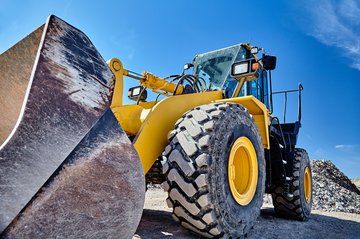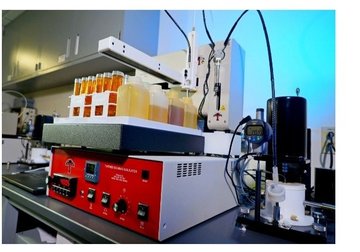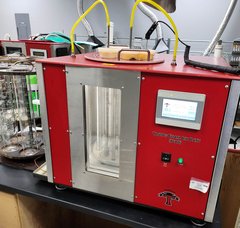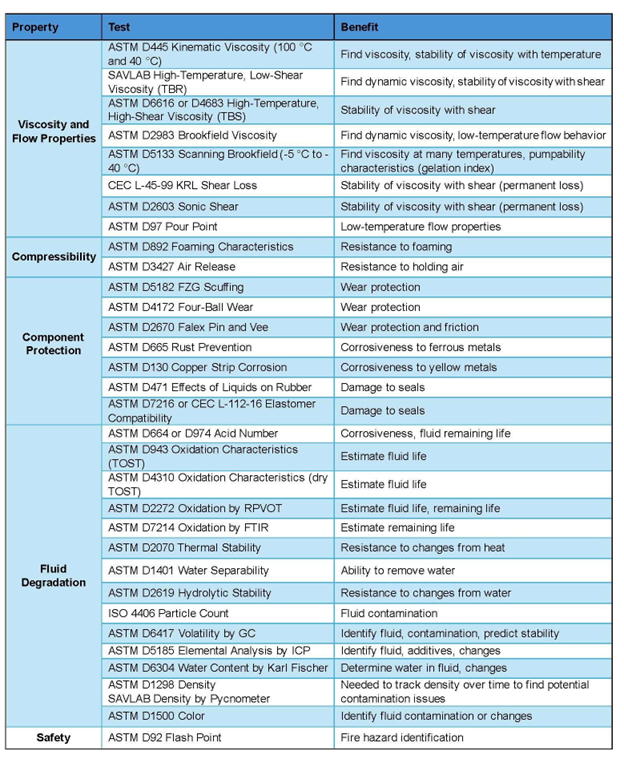Understanding Hydraulic Fluids: Properties, Testing, and Maintenance Considerations
 Hydraulic
fluid is essential for a range of applications, including automotive braking
systems, industrial machinery like forklifts and construction equipment,
and hydraulic lifts. It serves to transmit force and mechanical power
throughout machines by responding to applied pressure. Viscosity, which
affects flow efficiency, is crucial. Viscosities being too high can lead
to frictional losses, while too low may cause leaks. Maintaining
incompressibility is vital to prevent issues like sponginess in hydraulic
systems, often caused by air bubbles or foam.
Hydraulic
fluid is essential for a range of applications, including automotive braking
systems, industrial machinery like forklifts and construction equipment,
and hydraulic lifts. It serves to transmit force and mechanical power
throughout machines by responding to applied pressure. Viscosity, which
affects flow efficiency, is crucial. Viscosities being too high can lead
to frictional losses, while too low may cause leaks. Maintaining
incompressibility is vital to prevent issues like sponginess in hydraulic
systems, often caused by air bubbles or foam.Moreover, hydraulic fluids provide lubrication and protection against wear for system components like pumps and pistons. They contain anti-wear additives to safeguard surfaces under high pressure. However, fluids must also avoid reacting with system materials and causing corrosion or seal damage. Contaminants such as water and oxidation byproducts pose significant risks, leading to corrosion, sticky varnishes, or abrasive particles that wear down components. Effective filtration is necessary to remove contaminants while preserving beneficial additives.
Practical considerations include minimizing costs, safety hazards, and environmental impact. Longer service life and the use of non-toxic, environmentally friendly additives are essential for sustainability and safety. Additionally, fire resistance is crucial in certain applications to prevent accidents. Overall, hydraulic fluids play a critical role in various industries, and their proper selection and maintenance are essential for efficient and safe operation.
Testing Hydraulic Fluids for Flow Properties
 Many hydraulic fluid tests examine viscosity and fluid
flow. ASTM D445 measures
kinematic viscosity. When determined at two temperatures, this test shows how
the fluid flows as it warms and cools. As it cools and becomes more resistant
to flow, pumpability is a concern. The Scanning Brookfield Test (ASTM D5133) examines whether a change in
structure (viscosity and/or gelation tendency) may prevent effective pumping at
cold temperatures. Low-temperature pumpability might be especially important
for hydraulics in a refrigerated warehouse. Other tests measure viscosity loss
under shearing conditions. That loss may last only as long as the fluid is
under shear forces or may be permanent. Combining tests for high-temperature,
low-shear viscosity (SAVLAB TBR) and high-temperature, high-shear
viscosity (ASTM D4683 or D6616) at the same temperature reveals both
temporary and permanent viscosity loss from shearing. KRL shear loss (CEC
L-45-99) or sonic shear (ASTM D2603) tests also show permanent viscosity
loss.
Many hydraulic fluid tests examine viscosity and fluid
flow. ASTM D445 measures
kinematic viscosity. When determined at two temperatures, this test shows how
the fluid flows as it warms and cools. As it cools and becomes more resistant
to flow, pumpability is a concern. The Scanning Brookfield Test (ASTM D5133) examines whether a change in
structure (viscosity and/or gelation tendency) may prevent effective pumping at
cold temperatures. Low-temperature pumpability might be especially important
for hydraulics in a refrigerated warehouse. Other tests measure viscosity loss
under shearing conditions. That loss may last only as long as the fluid is
under shear forces or may be permanent. Combining tests for high-temperature,
low-shear viscosity (SAVLAB TBR) and high-temperature, high-shear
viscosity (ASTM D4683 or D6616) at the same temperature reveals both
temporary and permanent viscosity loss from shearing. KRL shear loss (CEC
L-45-99) or sonic shear (ASTM D2603) tests also show permanent viscosity
loss.
Testing for
Incompressibility
 The
Foaming Characteristics (ASTM D892) and Air Release (ASTM D3427) tests relate to keeping air out of
the hydraulic fluid so it remains incompressible. In the foaming
characteristics tests, air is introduced into the fluid, creating foam. Fluids
with desirable anti-foaming characteristics will create minimal foam volumes.
The faster the foam dissipates, the more quickly air problems will resolve. Air
Release also times a fluid’s return to an acceptable minimum level after air is
added.
The
Foaming Characteristics (ASTM D892) and Air Release (ASTM D3427) tests relate to keeping air out of
the hydraulic fluid so it remains incompressible. In the foaming
characteristics tests, air is introduced into the fluid, creating foam. Fluids
with desirable anti-foaming characteristics will create minimal foam volumes.
The faster the foam dissipates, the more quickly air problems will resolve. Air
Release also times a fluid’s return to an acceptable minimum level after air is
added.
Testing for Protection
 Many
tests measure a fluid’s ability to protect machine components from damage. Rust
Prevention Test (ASTM D665) determines protection against rust,
Copper Strip Corrosion (ASTM D130) against corrosion of yellow metals,
and a higher acid number found using Acid Number (ASTM D664 or D974) generally indicates a more corrosive
fluid. Several Elastomer Compatibility Tests (ASTM D471, ASTM D7216, or CEC L-112-16) examine how the
fluid impacts the elastomer seals, Differences between these Elastomer
Compatibility Tests generally involve the specific reference material tested
with the fluid, and modifications may be appropriate for application-specific
seal materials. Many tests
measure protection against wear. A few of these include the FZG Scuffing Test (ASTM D5182), the Four-Ball Wear Test (ASTM D4172), and the Falex Pin and Vee Test (ASTM D2670). These tests use different
mechanisms to create wear and may be listed in different specifications. For
instance, ASTM D6158-18 specification requires the scuffing test, while
FED-STD-791 requires the four-ball test. Consideration of the type of wear likely
in a particular system and discussion with a testing expert at Savant Labs may
help select a wear test.
Many
tests measure a fluid’s ability to protect machine components from damage. Rust
Prevention Test (ASTM D665) determines protection against rust,
Copper Strip Corrosion (ASTM D130) against corrosion of yellow metals,
and a higher acid number found using Acid Number (ASTM D664 or D974) generally indicates a more corrosive
fluid. Several Elastomer Compatibility Tests (ASTM D471, ASTM D7216, or CEC L-112-16) examine how the
fluid impacts the elastomer seals, Differences between these Elastomer
Compatibility Tests generally involve the specific reference material tested
with the fluid, and modifications may be appropriate for application-specific
seal materials. Many tests
measure protection against wear. A few of these include the FZG Scuffing Test (ASTM D5182), the Four-Ball Wear Test (ASTM D4172), and the Falex Pin and Vee Test (ASTM D2670). These tests use different
mechanisms to create wear and may be listed in different specifications. For
instance, ASTM D6158-18 specification requires the scuffing test, while
FED-STD-791 requires the four-ball test. Consideration of the type of wear likely
in a particular system and discussion with a testing expert at Savant Labs may
help select a wear test.
Testing for Resistance to
Fluid Degradation
 Many different hydraulic fluid tests
assess fluid degradation. These tests predict how long a fluid will retain its critical
properties or measure the actual degradation of an in-service fluid. Oxidation
tests, such as Oxidation Characteristics/TOST (ASTM D943), Oxidation Characteristics/Dry TOST
(ASTM D4310), and Oxidation by RPVOT (ASTM D2272), artificially apply conditions with
increased oxygen and high temperatures to stress the fluid. The measurements
determine how long the fluid resists breakdown from these stressors. While
results may not predict a specific number of service hours, a better result in
an oxidative test indicates a longer expected service life. The Thermal
Stability Test (ASTM D2070) is similar but focuses on elevated
temperature, not oxygen exposure. When applied to a fresh and in-service fluid,
some oxidation tests, such as ASTM D2272 or Oxidation by FTIR (ASTM D7214), measure whether antioxidant
additives are depleted. The Hydrolytic Stability Test (ASTM D2619) also focuses on predicting service
life. It tests how well fluid can resist changes in the presence of water.
Better results imply a longer service life and better suitability for
applications where water contamination is likely. Tests for the presence of
water, such as the Water Content by Karl Fischer Test (ASTM D6304), and tests to determine the Particle
Count (ISO 4406) reveal contamination of in-service fluids. The Water
Separability Test (ASTM D1401) evaluates the ease of separating
water from samples when they are contaminated. Filterability tests verify that
only contaminants, not fluid components, are removed during filtration. Both
tests indicate the possibility of extending service life by removing
contaminants. Testing for volatility (ASTM D6417) can indicate whether a fluid could
lose some of its critical properties as the lightest components evaporate. When
applied to an in-service fluid, changes in volatility can indicate
contamination. Changes in fluid composition by elemental analysis (ASTM D5185), density (ASTM D1298), or color (ASTM D1500) also indicate contamination or other
fluid degradation.
Many different hydraulic fluid tests
assess fluid degradation. These tests predict how long a fluid will retain its critical
properties or measure the actual degradation of an in-service fluid. Oxidation
tests, such as Oxidation Characteristics/TOST (ASTM D943), Oxidation Characteristics/Dry TOST
(ASTM D4310), and Oxidation by RPVOT (ASTM D2272), artificially apply conditions with
increased oxygen and high temperatures to stress the fluid. The measurements
determine how long the fluid resists breakdown from these stressors. While
results may not predict a specific number of service hours, a better result in
an oxidative test indicates a longer expected service life. The Thermal
Stability Test (ASTM D2070) is similar but focuses on elevated
temperature, not oxygen exposure. When applied to a fresh and in-service fluid,
some oxidation tests, such as ASTM D2272 or Oxidation by FTIR (ASTM D7214), measure whether antioxidant
additives are depleted. The Hydrolytic Stability Test (ASTM D2619) also focuses on predicting service
life. It tests how well fluid can resist changes in the presence of water.
Better results imply a longer service life and better suitability for
applications where water contamination is likely. Tests for the presence of
water, such as the Water Content by Karl Fischer Test (ASTM D6304), and tests to determine the Particle
Count (ISO 4406) reveal contamination of in-service fluids. The Water
Separability Test (ASTM D1401) evaluates the ease of separating
water from samples when they are contaminated. Filterability tests verify that
only contaminants, not fluid components, are removed during filtration. Both
tests indicate the possibility of extending service life by removing
contaminants. Testing for volatility (ASTM D6417) can indicate whether a fluid could
lose some of its critical properties as the lightest components evaporate. When
applied to an in-service fluid, changes in volatility can indicate
contamination. Changes in fluid composition by elemental analysis (ASTM D5185), density (ASTM D1298), or color (ASTM D1500) also indicate contamination or other
fluid degradation.

Savant’s Hydraulic Fluid Testing Capabilities
Savant Labs has extensive experience with all of these
hydraulic fluid tests. In addition to testing new fluids for specifications, we
offer customized projects to address particular problems. In one case study,
the customer was evaluating new fluids for their company-wide hydraulic
systems. As part of the project, we tested some of the customer’s in-service
fluids. Clues like wear metals revealed during elemental analysis, poor
oxidation resistance, and permanent viscosity loss due to shearing helped the client identify unmet lubricant needs to be addressed
with their new fluid choice. Our analysts also tested several proposed fluids
and recommended which would perform best under the customer’s service
conditions. Whether you need to confirm your newly developed fluid is meeting
specification limits, verify that a fluid is the right one for your application,
or monitor your in-service hydraulic fluids, Savant Labs can meet your
needs. Contact Savant
Labs for a quote on standard hydraulic fluid testing or to learn more about our
custom testing capabilities.
